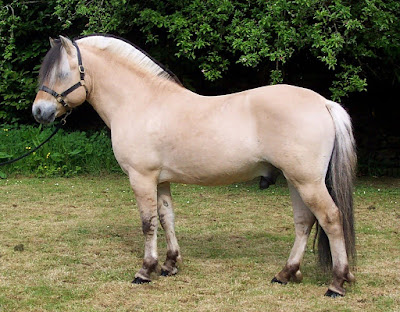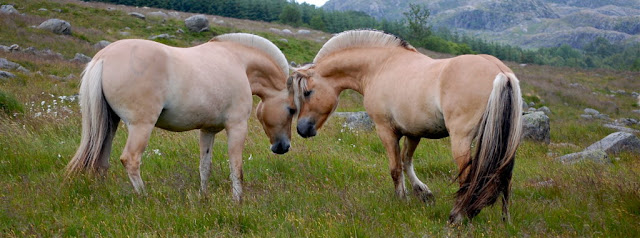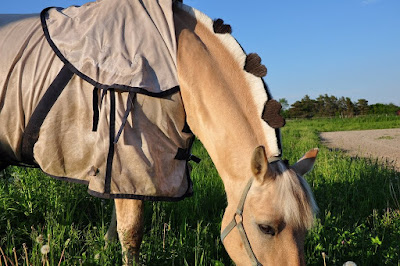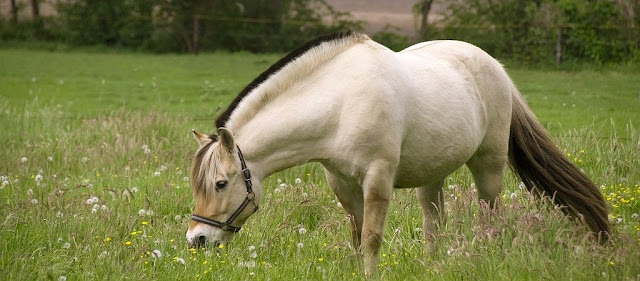The Norwegian Fjord is considered one of the oldest pure
breeds of horse. While they bear a striking resemblance to the Asiatic wild
horse or Przewalski horse, they are in fact more closely related to the
European wild horse, the Tarpan, as the Przewalski horse has 66 chromosomes
while both the Fjord and the Tarpan have 64.
It is believed that the original Fjord horse migrated to
Norway and was domesticated over 4000 years ago. Archeological evidence
suggests that the Fjord horse has been selectively bred for over 2000 years,
first by the Vikings around 1200 BC. Rune stone carvings in Norway, many of
fighting stallions, show images of horses recognizable as Fjords. The Vikings
took their Fjords, which they used as war mounts, in their travels to Scotland,
Iceland, and elsewhere. In these lands the Fjord influenced the Highland Pony
and the Icelandic Horse.
Breed Description
This breed ranges from 13 to 14.2 hands high and weighs 900
to 1200 pounds. They are dun in color with a dorsal stripe running along the
midline of the back. 90 percent are brown duns, with the other acceptable
colors being red, grey, white or yellow dun.
They are known for their distinctive two toned mane which is
black in the center, sandwiched between shorter, lighter hair. It is usually
cut short enough to stand upright, with the center black hairs left longer to
display the black stripe. Fjords are long lived, and it is not unusual for them
to live into their late 30's.
Physical Characteristics
Interestingly, although it is called a horse, the Fjord is
technically a pony. Most Fjords are only about 54 to 58 inches at maturity.
Yet, despite its small size, it has a strong built and is traditionally
considered to be powerful hard worker. It is this work ethic that Norwegians
have praised for centuries, and has made the Fjord such a treasured animal in
Norway.
In terms of its physical appearance, the Fjord possesses
some distinguishable characteristics. The Fjord’s head is medium in size and
well-defined, with a broad, flat forehead and a straight or slightly dished
face. Its eyes are large and its ears are small and alert, whereas the neck is
well-muscled and crested. The Fjord's body is short, coupled with good depth,
large heart girth, and well-developed muscles. Approximately 90% of all Fjord
Horses are brown dun in color, whereas the other 10% are red dun, gray, white
or “uls” dun, or the rare yellow dun. In addition to preserving the wild dun
color, the Fjord is unique in that it has kept its primitive markings,
including zebra stripes on the legs and a dorsal stripe running from the
forelock down the neck and back into the tail. Some Fjords also possess dark
stripes over the withers. Another distinctive characteristic of the Fjord is
its mane; the center hair of the mane is dark while the outer hair is white.
Common practice is to cut the center hairs of the mane short so that it stands
straight up. The mane is then traditionally trimmed in a crescent shape to
emphasize the graceful curve of the Fjord’s neck; the white outer hairs are
trimmed slightly shorter than the dark inner hair to display the dramatic
stripe.
In the early 1900s, specific breeding guidelines for the Fjord Horse
were not established; hence, cross-breeding did occur between Fjords and other
breed types. However, with the growth in the perception of the Fjord Horse as a
Norwegian cultural heritage during the course of the century, advocates of a
pure Fjord Horse were becoming increasingly vocal, and eventually came together
in establishing protection mechanisms for the original Fjord. At this point,
there were not international guidelines and Norway was not recognized as the
motherland of the Fjord, but through these early efforts, which effectively
initiated controlled and systematic breeding practices, the Fjord Horse has
today’s become one of the world’s only horse breeds to retain all of its
original physical characteristics, and is today in a strong position within
Norway and internationally.
Size
13.1 to 14.3 hands
Colours
The most common coat colors of the horses in this breed are
various shades of dun (brown dun, red dun, grey dun, white dun, yellow-white
dun)
Appearance
Although the Norwegian Fjord is generally of pony size, they
are always referred to as Fjord horses. This reflects the fact that it looks far
more like a cut-down draught horse than like a typical pony. Admirers of the
breed have been known to claim that the Norwegian Fjord can do two-thirds of
the work of the large draught breeds with only a fraction of their care
requirements. The strength of the Norwegian Fjord is obvious in every way from
its well-muscled neck to its thick legs and powerful quarters. Norwegian Fjords
are always dun and the vast majority of them are brown dun, essentially a tan
colour. Although their manes and tails are naturally thick and full, their
manes are traditionally trimmed into a crescent shape, which shows off the
black hairs in their otherwise white manes
Some Interesting Facts
Because the breeding of these equines took place mostly in
the western part of Norway, this breed came to be known as “Vestlandshesten”,
which means, ‘the horse of the western country’.
At times, these horses can have one or more dark stripes
over their withers, however, that is very rare.
It is not permitted to crossbreed the Fjord, and doing so
will result in revocation of breeding privileges.
The Fjord horse is one of Norway’s three native breeds.
In the tourist industry, this equine is used as a symbol of
Norwegian traditional.
Though a few specimens of these horses might fall under the traditional
cutoff between ponies and horses, the Fjord horse is considered a horse,
irrespective of its size.
In modern Norway and the Scandinavian countries, the Fjord
is used in therapy for disabled people, as also in riding schools for children.
The Fjord is one horse that suits riders of all skill
levels. The Fjord horses can often be found in Olympic sporting events like
Dressage.




















No comments:
Post a Comment